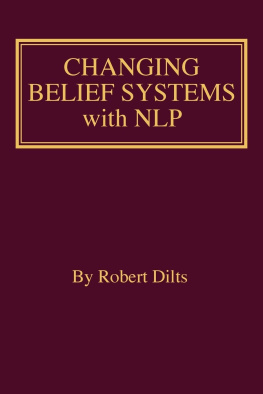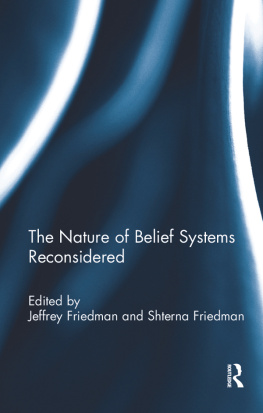Robert Dilts - Changing Belief Systems With NLP
Here you can read online Robert Dilts - Changing Belief Systems With NLP full text of the book (entire story) in english for free. Download pdf and epub, get meaning, cover and reviews about this ebook. year: 2018, publisher: Dilts Strategy Group, genre: Religion. Description of the work, (preface) as well as reviews are available. Best literature library LitArk.com created for fans of good reading and offers a wide selection of genres:
Romance novel
Science fiction
Adventure
Detective
Science
History
Home and family
Prose
Art
Politics
Computer
Non-fiction
Religion
Business
Children
Humor
Choose a favorite category and find really read worthwhile books. Enjoy immersion in the world of imagination, feel the emotions of the characters or learn something new for yourself, make an fascinating discovery.
- Book:Changing Belief Systems With NLP
- Author:
- Publisher:Dilts Strategy Group
- Genre:
- Year:2018
- Rating:3 / 5
- Favourites:Add to favourites
- Your mark:
- 60
- 1
- 2
- 3
- 4
- 5
Changing Belief Systems With NLP: summary, description and annotation
We offer to read an annotation, description, summary or preface (depends on what the author of the book "Changing Belief Systems With NLP" wrote himself). If you haven't found the necessary information about the book — write in the comments, we will try to find it.
Changing Belief Systems With NLP — read online for free the complete book (whole text) full work
Below is the text of the book, divided by pages. System saving the place of the last page read, allows you to conveniently read the book "Changing Belief Systems With NLP" online for free, without having to search again every time where you left off. Put a bookmark, and you can go to the page where you finished reading at any time.
Font size:
Interval:
Bookmark:
Changing Belief Systems with NLP
by
Robert Dilts

Dilts Strategy Group
P.O. Box 67448
Scotts Valley, California 95067
Phone: +1(831) 438-8314
E-Mail:
Homepage: http://www.diltsstrategygroup.com
Copyright 1990 by Robert B. Dilts and Dilts Strategy Group. All rights reserved. This book or parts thereof may not be reproduced in any form without written Permission of the Publisher.
Library of Congress Card Number 90-060084
I.S.B.N. 978-1-947629-26-4
I.S.B.N. 978-1-947629-31-8 (e-book)
I.S.B.N. 10: 0-916990-24-9
I.S.B.N. 13: 978-0-916990-24-4
Contents
Dedication
This book is dedicated with deepest respect to the peoples of Eastern Europe who have shown the world the power and the reach of true belief change.
Acknowledgements
Credit History
There are a number of different elements in the creation and development of something, whether it be an object, theory, technique or idea. First of all, most products of creation have both a conceptual and operational side. The conceptual elements are the ideas that serve as the theoretical foundation of the product. The operational elements have to do with the implementation of ideas.
In terms of the conceptual and operational development there are a number of basic roles. There is the primary creator role which typically serves as the focal point for the development.

Then there is the conceptual and operational background sup port, contributing support and those who make further adaptations and refinements of the material.
While I served as the focal point for the development of the techniques described in this book, there are many people to acknowledge for their support roles.
For example, the technique of Reimprinting had both a conceptual and an operational history. Conceptually, Reimprinting is drawn from the background concept of "Imprinting" of Konrad Lorenz, which was extended to "re-imprinting" by Timothy Leary. It is also conceptually supported by Sigmund Freuds ideas from "Studies in Hysteria" and the family systems work of Virginia Satir. Operationally, however, Reimprinting is drawn primarily from the Change history technique of NLP developed by Richard Bandler and John Grinder.
The Failure into Feedback technique is primarily an extension of the work on accessing cues and cognitive strategies begun my colleagues and myself in the early days of NLP and described in the book Neuro-Linguistic Programming Vol. I. The innovative relational aspects of the process, however, were stimulated by the work of Max Wertheimer and his colleagues in the area of Gestalt Psychology.
The Belief Integration process draws operationally from a combination of the NLP techniques of the Visual Squash and Reframing. Conceptually, it has been heavily influenced by the work of Fritz Perls and Virginia Satir.
On a fundamental conceptual level, the notion of Logical Levels in belief change is drawn from Gregory Batesons applications of logical levels in his studies of systems and schizophrenia. And much of the inspiration for the methods of applying these ideas was derived from the innovative work of Milton H. Erickson, M.D.
The physicalization of the time-line came from a series of innovations that arose out of a set of seminars I did with John Grinder called Syntax, as did the identification and physical changing of perceptual positions in the Meta Mirror technique.
A lot of incidental conceptual and operational support came from my colleague Todd Epstein who serves as the primary beta test site for many of my ideas.
On the production side of this book, many thanks go to Louis Bellier who transcribed and prepared the initial manuscript that served as the foundation for the book and Alain Moenart and Anne Pierard who sponsored the seminar from which the manuscript was drawn.
Introduction
Our beliefs are a very powerful force on our behavior. It is common wisdom that if someone really believes he can do something he will do it, and if he believes something is impossible no amount of effort will convince him that it can be accomplished. Beliefs like Its too late now; Theres nothing I can do anyway; Im a victim... My number came up; can often limit a person from taking full advantages of their natural resources and unconscious competence. Our beliefs about ourselves and what is possible in the world around us greatly impact our day-to-day effectiveness. All of us have beliefs that serve as resources as well as beliefs that limit us.
Most people recognize, for instance, that their belief systems can both directly and indirectly effect their health. It is often a simple matter to identify negative beliefs that lead to health related problems like substance abuse, constant fatigue, lowering of the bodys natural defenses, and stress. Yet, how does one go about changing negative beliefs into beliefs that contribute to health?
Almost every health professional acknowledges that the attitude of the patient is a major contributing factor to the success of their recovery. Yet very few explicit or reliable methods exist to help someone get over their response of fear or apathy to achieve a congruent positive attitude.
Throughout the history of medical research, placebos have been shown to be as powerful as many drugs. As yet, however, the exact cause of this power has remained a mystery. Many researchers speculate that a reverse placebo effect may even cause many cases of illness. Is it possible to tap into that power directly and channel it to insure successful recovery?
Even the beliefs that others have about us can effect us. This was demonstrated in an enlightening study in which a group of children who were tested to have average intelligence was divided at random into two equal groups. One of the groups was assigned to a teacher who was told that the children were gifted. The other group was given to a teacher who was told that the children were slow learners. A year later the two groups were retested for intelligence. Not surprisingly, the majority of the group that was arbitrarily identified as gifted scored higher than they had previously, while the majority of the group that was labeled slow scored lower! The teachers beliefs about the students effected their ability to learn.
Our beliefs can shape, effect or even determine our degree of intelligence, health, relationships, creativity, even our degree of happiness and personal success. Yet, if indeed our beliefs are so powerful a force in our lives, how do we get control of them so they dont control us? Many of our beliefs were installed in us as children by parents, teachers, social upbringing and the media before we were aware of their impact or able to have a choice about them. Is it possible to restructure, unlearn or change old beliefs that may be limiting us and imprint new ones that can expand our potential beyond what we currently imagine? If so, how do we do it?
Next pageFont size:
Interval:
Bookmark:
Similar books «Changing Belief Systems With NLP»
Look at similar books to Changing Belief Systems With NLP. We have selected literature similar in name and meaning in the hope of providing readers with more options to find new, interesting, not yet read works.
Discussion, reviews of the book Changing Belief Systems With NLP and just readers' own opinions. Leave your comments, write what you think about the work, its meaning or the main characters. Specify what exactly you liked and what you didn't like, and why you think so.











